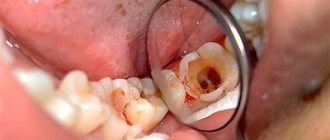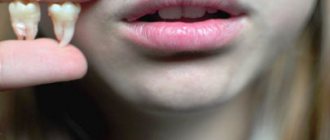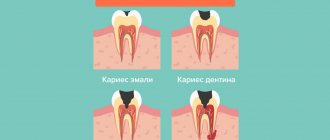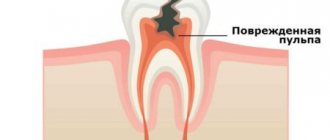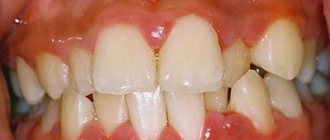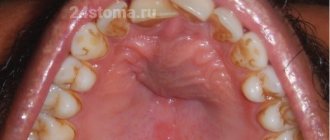Chronic pulpitis is a form of pulpitis, inflammation of the pulp. Pulp is the soft tissue of the tooth, which is responsible for the blood supply to its hard tissues and consists of nerve endings, blood vessels and connective tissue. As a rule, chronic forms of pulpitis occur when acute forms are suppressed, but sometimes they can be a primary process without an acute stage.
Chronic pulpitis is an inflammatory process of the nerves and blood vessels of the tooth, which gradually causes severe changes in structure and function. If the disease is present, a person reacts sharply to cold and hot foods and experiences pain while chewing solid food. Pathology can be accurately determined using x-rays and electroodontodiagnosis. The development of the chronic form occurs in the absence of proper treatment of acute pulpitis.
Fact: the disease is much more often detected in the chronic form rather than in the acute form. People aged 20-50 years are at risk.
Filling made of light-curing material for classes I and V - 2,000 rubles.
Filling made of light-curing material in classes II, III, IV - 3,000 rubles.
Placing a temporary filling - 400 rubles.
Resection of the root apex (frontal group) - 6,500 rubles.
Resection of the root apex (chewing group) - RUB 9,000.
Mechanical and medicinal treatment of canals for periodontitis (1 canal) - 1,100 rubles.
Closing perforations (MTA) - RUB 6,500.
At CELT you can get advice from a dental specialist.
- The cost of a dental consultation is 1,000
- The cost of an orthodontist consultation is 2,000
Make an appointment
Causes of pulpitis
Photos of chronic pulpitis are presented in this article. This disease can occur for various reasons.
The pathology can become chronic if acute pulpitis is not treated for 12 weeks. The disease appears due to toxins and bacteria. They penetrate into the pulp through channels and through the blood. Complications of deep caries, increased abrasion of enamel, mechanical injuries and opening of the pulp can contribute to the development of pathology.
Advanced caries
Ignoring the symptoms of caries and the lack of professional treatment can lead to the further development of this disease with penetration into the deep layers of dental tissue, including the pulp. Once in it, pathogenic microorganisms will cause inflammatory processes.
Incorrect treatment of caries
Sometimes pulpitis occurs after caries treatment has been carried out. The reasons for its occurrence may be the following:
- Not all tissues affected by caries have been removed, and they continue to have a destructive effect on the tooth;
- During treatment, the pulp was burned due to insufficient cooling;
- The bottom of the tooth cavity was dried with an air jet before filling.
Tooth injuries
The integrity of the tooth enamel can be damaged due to a blow to it or contact with hard food. If, as a result, the crown splits and the nerve is exposed, inflammation of the pulp in the near future is almost inevitable.
Retrograde pulpitis
Sometimes the infection penetrates into the dental pulp not from the oral cavity, but through the apical foramen in diseases such as periodontitis, osteitis, osteomyelitis.
Indications
- Mechanical damage to the tooth and violation of the integrity of the crown.
- The appearance of complications of deep caries and the penetration of infection into the canals.
- Exacerbation of the disease and pain syndrome.
- Incorrectly installed filling and progression of pathology.
- Detection of inflammation on an x-ray.
Contraindications
- Cardiovascular diseases in the acute stage.
- Pregnancy and prohibition on taking medications.
- Mental and nervous disorders.
- Poor blood clotting.
- Allergic reactions to anesthesia, antiseptics, antibiotics.
What is retrograde pulpitis?
Retrograde pulpitis is one of the rarest types of inflammation of the dental nerve. Its peculiarity is that the infection first affects the root part of the pulp, and then reaches the coronal part. Microbes penetrate into the tooth cavity through the apex of the root - that is, retrogradely, this feature is reflected in the name. Classic tooth pulpitis is the result of advanced caries, but with retrograde pulpitis it is not present; the causes of nerve inflammation are different.
How does the pulp become infected with retrograde pulpitis?
- Through the periodontal pocket - with inflammation of the gums, the ligaments around the root are destroyed, bacteria and microbes freely penetrate into the root tip.
- Through the blood - as a complication after chickenpox, rubella, influenza, sepsis.
- Through neighboring infected foci - against the background of sinusitis, osteomyelitis, chronic osteitis of the jaw, bone forms of actinomycosis.
Clinical manifestations
Treatment of chronic pulpitis does not always begin on time, since this disease is very insidious. Acute pain is always the reason for seeking professional help, but with chronic pulpitis, pain symptoms are not pronounced and the patient prefers to postpone his visit to the dentist. In this case, the disease develops quite quickly and, at best, will lead to an exacerbation of chronic pulpitis with severe pain symptoms or to the occurrence of periodontitis, in which it can be very difficult to save the tooth from removal. No less pleasant consequences may include the formation of cysts, ulcers, phlegmons and even sepsis. This is why timely diagnosis of chronic pulpitis is so important!
The main manifestation is an acute reaction to cold and hot food. However, it occurs late (sometimes 5-10 minutes after consuming food or liquid). In a calm state, a person experiences heaviness inside the tooth.
The hypertrophied form is not accompanied by severe pain. Overgrown tissue appears that ruptures when eating food. Pain may occur when eating hard foods or when pressing on the inflamed area.
Gangrenous pulpitis causes severe pain when eating hot food, which does not go away for a long time. The pulp begins to rot, which causes bad breath. The color of the tooth enamel changes (it becomes dark gray).
An exacerbation is accompanied by severe pain even without mechanical and thermal effects on the affected area. There are positive symptoms of vasoparesis, swelling of the gums, and pain in the trigeminal nerve.
Tooth pulpitis, what is it?
Pulpitis is an inflammatory process involving the pulp, which is the soft tissue inside the root canal of a tooth, consisting of blood and lymphatic vessels, as well as a large number of nerve endings. As a result of inflammation of the nerve fibers, acute toothaches of high intensity occur, which are almost impossible to endure. This pain syndrome is poorly controlled even with potent analgesic drugs.
As pulpitis progresses, an infectious process develops in the pulp chamber and harmful bacteria multiply. As a result, nerve endings and connective tissue begin to die, causing pus to form in the root canal. Untimely or improper treatment of pulpitis threatens the death of the nerve and a number of serious complications, as a result of which the nerve and tooth have to be removed. But if you consult a dentist in the early stages of the development of pulpitis, you can cope with the disease with therapeutic treatment, preserving the dental unit.
Types of chronic pulpitis
It is customary to distinguish the following types of chronic pulpitis:
- Hypertrophic – characterized by the formation of granulation tissue and dentin dystrophy. In this case, the overgrown granulations extend beyond the pulp chamber and enter the carious zone. If the form is polypous, then polyps are formed. Severe exacerbation can provoke pulp gangrene.
- Fibrous - differs from other types in that it leads to the appearance of coarse fibrous connective tissue. When examined, the pulp looks like a scar cord with a color change to white-gray. Gangrene, phlegmon and abscesses develop as complications.
- Gangrenous - represents complete tissue necrosis and tooth destruction (the color changes to gray-black). But in rare cases, it is possible to save small areas of the pulp.
Diagnosis of pulpitis
The basis for diagnosis is patient complaints and instrumental examination:
- A carious cavity is revealed, in which softened dentin is located;
- The tooth reacts painfully to changes in temperature;
- Tapping, as a rule, does not indicate a problem; sharp pain is observed at the point of contact of the carious cavity with the pulp;
The nature and depth of the process can be clarified using x-ray examination and electroodontodiagnosis.
Reviews about our doctors
I would like to express my gratitude to the dentist Elena Nikolaevna Kiseleva and her assistant Svetlana - they are real specialists and at the same time sensitive, not burnt out by years of practice.
Thanks to them, I have been coming back here for many years. Thanks to the management for such doctors! Read full review Svetlana Nikolaevna
13.08.2021
I am very grateful to Evgeniy Borisovich Antiukhin for removing my three eights. Especially considering that the lower tooth was not the simplest (it was located in an embrace with a nerve). The removal took place in 2 stages, one tooth under local anesthesia, two under general anesthesia. I had no idea that wisdom teeth could be... Read full review
Sofia
28.12.2020
Complications of pulpitis
Among the most common complications of pulpitis is periodontitis: a disease of the tooth root in which the tip of the tooth becomes inflamed. Another consequence of untreated pulpitis is a dental cyst. This is a small tumor, most often formed at the apex of the tooth root due to the spread of infection. Often the disease occurs due to medical errors. For example, if the dentist poorly cleaned the dental canals before filling and bacteria got there, then pulpitis may develop under the filling.
Treatment of chronic pulpitis
Since chronic pulpitis leads to irreversible changes in the pulp tissue, it is removed from the crown and root parts of the tooth. Treatment involves surgical intervention with depulpation and can be carried out using the following methods:
- vital - the pulp is removed under anesthesia, the root canals and tooth are filled;
- devital - a special paste is applied to the pulp, and then the already dead pulp is removed, the canals and the tooth itself are filled.
Vital extirpation is carried out in one visit and is considered a gentle method, but it cannot be used due to the patient’s allergic reaction to anesthetics or in case of obstruction of the dental canals. It is in these cases that the devital method is used, which requires 2, and sometimes 3 visits to the dentist.
Specifics of treatment of retrograde pulpitis
Treatment of retrograde pulpitis is carried out conservatively or surgically. Which option the doctor chooses depends on the stage and extent of the disease.
Types of treatment for retrograde pulpitis
Inflammation in an advanced form can only be treated surgically, that is, with complete removal of the pulp. With the conservative method, the dentist fights for the pulp; it is not removed. This method is only suitable for treatment in the initial stage.
Stages of treatment of retrograde pulpitis using a conservative method
- The doctor administers anesthesia.
- Opens the crown, cleans and treats the canals, then fills them.
- If the treatment takes place in one stage, a permanent filling is placed on the crown of the tooth. If several visits are planned, a temporary filling is installed.
Stages of surgical treatment of retrograde pulpitis
- The patient is given an anesthetic injection.
- The doctor opens the crown, thoroughly cleans the dental canals, and removes the pulp.
- The cavity is treated with an antiseptic and sealed.
- After 2 - 3 days, the dentist treats the cavity again and places a permanent filling.
Recommendations after treatment
The only way to avoid relapse is to maintain proper oral hygiene and visit the dentist regularly. The appearance of pain in a tooth at rest or while eating is a good reason to visit a specialist, as this reflects an inflammatory process in the pulp. Professional cleaning of the oral cavity and visiting the dentist 2 times a year will help you prevent the recurrence of chronic pulpitis. If, after treatment from a specialist, you notice an acute reaction to cold and hot food, experience pain when pressing on your gums and teeth, or notice swelling and discoloration of the enamel, be sure to make an appointment with your doctor.
In the dental department of the CELT clinic, treatment of chronic forms of pulpitis is carried out using modern diagnostic equipment and high-quality filling materials.
Make an appointment through the application or by calling +7 +7 We work every day:
- Monday—Friday: 8.00—20.00
- Saturday: 8.00–18.00
- Sunday is a day off
The nearest metro and MCC stations to the clinic:
- Highway of Enthusiasts or Perovo
- Partisan
- Enthusiast Highway
Driving directions
How to recognize pulpitis? Symptoms and signs of the disease
- The first signs of pulpitis are expressed in a painful reaction of the teeth to temperature changes or other irritants.
- Complaints of a sharp toothache, worsening at night, are a sign of already progressing pulpitis.
- Attacks of pain occur on their own, but can appear or intensify when biting, from inhaled air, or from changes in food temperature.
- Very often it is difficult to determine which tooth is affected, since half of the head hurts. With pulpitis of a tooth located in the upper jaw, pain can radiate to the temple, or to the ear - with inflammation of the pulp in the lower jaw.
- When moving from serous inflammation of the pulp to purulent inflammation, the severity of toothache increases. As the purulent process spreads, the toothache takes on a shooting, pulsating, tearing character, and pain-free intervals shorten.
- In the acute form of pulpitis, there may be an increase in body temperature, pain and enlargement of the nearest lymph nodes.
External signs will also help identify pulpitis:
- grayed enamel,
- tooth mobility,
- bleeding,
- redness of the gums,
- the presence of swelling in the area of the diseased tooth,
- formation of a fistula tract.
Untreated acute pulpitis, as a rule, turns into a chronic form, which is characterized by an asymptomatic course or manifests itself in aching pain.
- As a rule, it is characterized by a putrid odor from the mouth.
- Sometimes there is a toothache, aggravated by hot food, and subsided by cold food.
- When visiting a doctor in the chronic form, proliferation of pulp tissue is often diagnosed.
Symptoms of pulpitis may be similar to signs of other diseases (trigeminal neuralgia, periodontitis, etc.), therefore self-diagnosis and self-medication are unacceptable.
How long will a tooth last after pulpitis treatment?
Proper treatment of pulpitis allows the patient to forget about the diseased tooth for a long time.
True, there are some nuances.
- Firstly, since pulpitis occurs most often in teeth that have been significantly destroyed by caries, saving the tooth requires not only proper treatment of the pulpitis itself, but also adequate restoration of the coronal part.
- Secondly, after treatment of pulpitis, a tooth can sometimes change its color: it becomes grayish and loses its former shine.
- Thirdly, sometimes at the time of treatment (especially when seeing a doctor is delayed), inflammation of the dental pulp is complicated by periodontitis - inflammation of the tissues surrounding the tooth or periodontium. Then the doctor changes tactics and adds the stage of temporarily filling the tooth with antiseptic paste. Such a tooth may cause pain when biting for some time after treatment.
- Fourthly, a tooth treated endodontically (that is, with root canal treatment) needs periodic examinations and x-rays to exclude re-inflammation.
